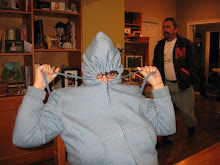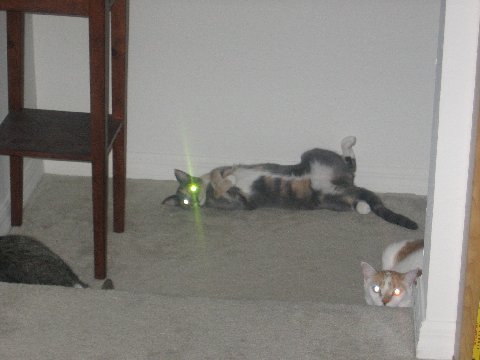In my pursuit of reading the Pulitzers, I purchased this gorgeous copy of T.S. Stribling's 1933 winner, The Store. I'm sure I spent quite a bit of money on it - it's leather-bound, gilt-edged, and has a ribbon bookmark - I'll be adding it to my permanent collection.
This book, the second in Stribling's trilogy, follows the further adventures of the Vaiden family, focusing specifically on Miltiades Vaiden. It is now post-Reconstruction in Florence, Alabama. Milt hasn't made much of himself since his days as a Civil War hero and local leader of the Ku Klux Klan. Milt is still rankled by what he perceived as a local store owner's "theft" of cotton from the family, and he sets out to get the family's rightful property (or the money owed them therefrom) back from the store owner, J. Handback.
Where Stribling really excels in this book, as he did in his last, is in the close examination of race relations in the post-Reconstruction South. With the recent events in Ferguson, Missouri, it was clear to me that we haven't come that far since the late 1800's - certainly not as far as we should have. White landowners in the South are struggling with how to deal with former slaves who now have rights. Milt Vaiden embodies the lost soul of the white Southerner who has been thrust into an existence that he is neither prepared nor happy for. Once a Civil War hero, a successful overseer, and leader of the KKK, in the New South, Milt Vaiden doesn't know what to do with himself. The book explores the lives of former slaves as they, too, seek to learn how to make do in a land where they no longer have the protection of their former owners, but do not quite have a fully independent existence, due to how they are seen and treated by most whites in the South. The book also explores the lives of those biracial products of rape and/or consensual relations between (usually) white male slave owners and their former slaves, particularly through the person of Toussaint Vaiden. How is a man who is neither white nor black to make his way in the world after the Civil War? Where does he belong, and how does he fit into the self-segregated society that is blossoming after Reconstruction?
As in the last novel, there are many uses of derogatory names for former slaves. The casual way the n-word is used is by far the most disturbing part of the novel, although I'm sure it was par for the course in that time and place (and may still be in some places). There were no rapes in this novel, but ***SPOILER ALERT*** there is a lynching at the very end. Not recommended for those who would be overly offended by these issues.
I give this book five out of five Whatevers. I see why it won the Pulitzer. There is so much about it to admire - the way Stribling strips down race relations after the War and really tries to present both sides of the issue; the slight tinge of spiritualism that invades the book; the examination of love, and the many ways in which one can love another person. I couldn't put it down over the Thanksgiving break, and I'm very glad I read it. I would not say that I liked Milt Vaiden, as a character...he was somewhat of a scalawag. But there were other characters I loved (including Gracie, former slave of the Vaiden family, and Lucy, the educated black woman who tries to teach the neighborhood's black children and eventually marries Toussaint). Highly recommended for an interesting look at the Old South as it became the New South, and for a look at race relations that might just be needed in today's society, as well.
2014-11
Saturday, November 29, 2014
Wednesday, November 26, 2014
Review: Guardian of the Trust by Irene Radford
After reading the first novel in this series, Guardian of the Balance, I decided I needed to get the second book, so I bought it off of Amazon. This book brings us to the early 1200's in England - Arylwren's dedcendant, Resmiranda Griffin (Ana), shares the magical abilities of her ancestor, but having been raised in the Church, she is hesitant to use magic. As a child, she is pursued by a dark force which she doesn't understand, so she spends much of her formative years running from convent to convent, hiding from the man with the black aura who seeks her. As an adult, she meets Sir Hugh Fitz Chenenoir, who saves her from a raid on her latest hiding place, and the two begin to fall in love. However, the two are soon separated. Can Ana defeat the man with the black aura? Will she and Sir Hugh ever be reunited?
I did enjoy this book, but not as much as the first. There was a lot more history in this one - King John, the Crusades, even a bit of a cameo by Robin of Locksley. Sometimes the court intrigue and royal history got to be a little much. I did enjoy the magical parts, and the love story between Ana and Hugh. But I didn't like Ana as much as I liked Wren, in the first book. I'm not sure why. Maybe it was that she was much more religious than Wren, and more reluctant to use her magic. She spent a lot of the book dithering about whether or not using magic would estrange her from God. I just wasn't into the religious overtones, although I understand that it was a symptom of the times.
Recommended for fans of the first book, for anyone who likes a pretty solid love story, and for anyone who enjoys stories about the Middle Ages. Four out of five Whatevers. I'll be checking out the next one, if only to find out which descendant of Ana it deals with.
2014-10
I did enjoy this book, but not as much as the first. There was a lot more history in this one - King John, the Crusades, even a bit of a cameo by Robin of Locksley. Sometimes the court intrigue and royal history got to be a little much. I did enjoy the magical parts, and the love story between Ana and Hugh. But I didn't like Ana as much as I liked Wren, in the first book. I'm not sure why. Maybe it was that she was much more religious than Wren, and more reluctant to use her magic. She spent a lot of the book dithering about whether or not using magic would estrange her from God. I just wasn't into the religious overtones, although I understand that it was a symptom of the times.
Recommended for fans of the first book, for anyone who likes a pretty solid love story, and for anyone who enjoys stories about the Middle Ages. Four out of five Whatevers. I'll be checking out the next one, if only to find out which descendant of Ana it deals with.
2014-10
Thursday, November 6, 2014
Review: Hold the Dream by Barbara Taylor Bradford
I read A Woman of Substance, the first book in the Emma Harte series, a few months ago, and I loved it. I wasn't sure the second book would measure up, but it certainly did. Emma was still around in this one, but it mostly focused on Paula, her granddaughter, who took over the company when Emma went into semi-retirement. There isn't much to say about this one. It was much of the same corporate intrigue and family drama that populated the first book in the series. I don't know why, but these books give me a nice, cozy feeling when I read them. They remind me of the 80's, although they are set a little earlier than that. I guess it's the materialistic 80's mentality - "Greed is good" and all that. But I find it enjoyable to read about the joys and sorrows of the Harte clan. Four out of five Whatevers. Recommended for those who like corporate intrigue, family drama, or 80's-style writings (see above).
2014-9
2014-9
Subscribe to:
Posts (Atom)





